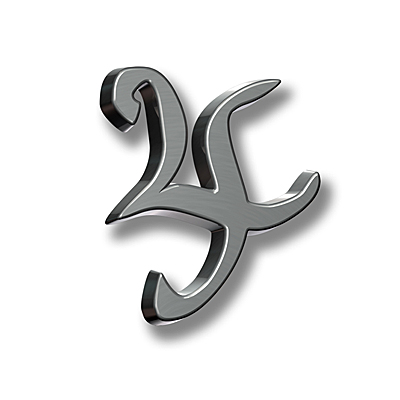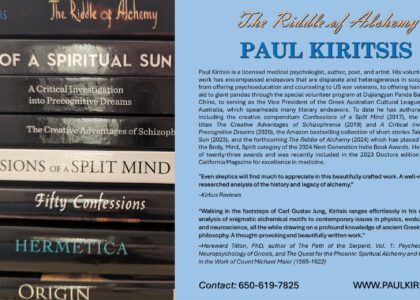
The formative force of the cosmos actively expressed by the planet Jupiter and passively by the metal tin represents a rupture that stands much closer to the feminine aesthetic pole of lunar consciousness than to the masculine aesthetic pole of solar consciousness. We know this by looking at the relative position of the geometric figures on the esoteric symbol that expresses this power; the lunar crescent sprouts from the level arm of the cross, meaning that the Jovian force actually manifests between that of the Saturnine and Lunar. Sitting between the two just mentioned the Jovian influence facilitates retainment of the original paradisal state of receptivity and purity. Under the little energetic pocket symbolised by the Jovian force the soul has awakened, incarnated or acquired sentience and has begun to emerge from the chaos and density of the elementary quartet. The initial upward movement that breaks the spell of paralytic inertia, an indigenous condition of the prima materia, is generated by the intellectual and spiritual powers of the unconscious and raises the coagulating soul out of the abyssal depths wholly regenerated and transformed. Alchemically speaking this stage can be equated to the chemical process of distillation or sublimation which seeks to extract the volatile spirit from its base matter by subjecting the entire body to sweltering temperatures to vaporise the substance and render it into a condensate whose level of refinement was wholly dependent upon the amount of distillations; the greater the number of cycles, the purer the substance.
The properties and uses of Jove’s metal have been known since about the third millennium bce. The ancient Persians incorporated it into their jewellery whilst the ancient Egyptians made ample use of its salts as a mordant for dyeing materials. Acting as its principle advocate in the ancient world, the Phoenicians imported tin from the Near East along with the British Cornwell, a place both revered and renowned for its tin deposits since the dawn of the Bronze Age. Homer himself, no doubt cognizant of the qualitative connection between the planetary god Jupiter and the metal tin, alludes to it in his epic poem The Odyssey when the protagonist Odysseus beaches ashore the enchanting shores of Conwell. Interestingly the etymological root of our contemporary term for the metal can probably be traced back to the eighth century bce, a date which is also agreed upon by the existing scholarly consensus to encompass the life and times of this great epic poet. Living in an area of Italy which constitutes modern-day Tuscany at this time were the Etruscans, a panentheistic and polytheistic race either from the indigenous Villanova culture or the Near East who called the Jovian emanation Tins and Tinia. Consequently ample trade and with the British Isles enabled cultural exchange and linguistic adoption of these terms by the Anglo-Saxons.
Many centuries afterwards the Romans would ascribe to tin the name plumbum album, a Latin word meaning ‘whitehead’ and proceed to mastermind an innovation of the highest calibre. Firstly the metal would be unearthed from the ground and separated from its ore through searing fires harnessed by metallurgical purification. Following this extraction, metallurgists would render the metal into tinfoil and subsequently pass it onto glass-makers whose dexterous hands would work it into the face of mirrors. After the Romans, practical use of the metal gradually dwindled and died out. It wasn’t until the late Middle Ages that tin experienced a renaissance, spawned to life by the operative ambitions of many alchemists like Paracelsus and Johannes Agricola. Of interest to most was the alchemical preparation of the metal’s salts, a procedure which involved drenching calcined salts in vinegar and then heating the entire admixture in an athanor (alchemical furnace) to produce salt crystals. Igniting these with charcoal produced the metal oxide. Alchemists of the late Middle Ages and the Renaissance were acquainted with both the stannic chloride or tin tetrachloride, called sal jovis, and the metallic binoxide or dioxide, known as calx jovis. Their association to the Jovian planet and deity, as well as to the Jovian qualities of expansion, cheerfulness, wisdom and preservation is implied in their shared use of the epithet jovis. Tin was sometimes sublimated with mercury, sulphur and sal ammoniac to create a golden crystalline powder called Aurum musivum (mosaic gold) which was used for the treatment of nervous disorders like chronic hysteria and muscular convulsions.
At around this time the metal was also found suitable for incorporation into pewter, a pliable alloy that could be fashioned into a great many implements including household utensils and nearly all church paraphernalia. Like its celestial equivalent which radiates with a brilliance and nobleness that seem eternal to our ephemeral eyes, corporeal tin radiates light and resists deterioration. Divers who examined eight tons of pewter within a fifteenth century Portuguese shipwreck off the coast of Namibia some time ago claimed that the alloy gleamed in such a way that abetted the illusion that it had just sunk.








